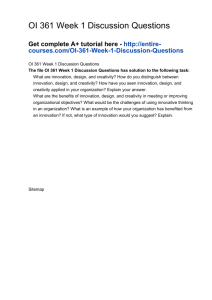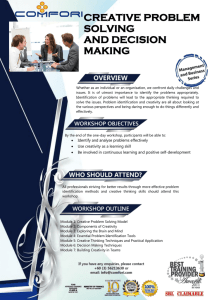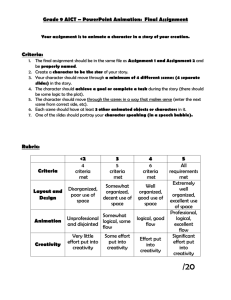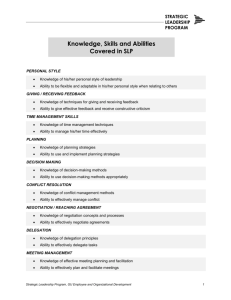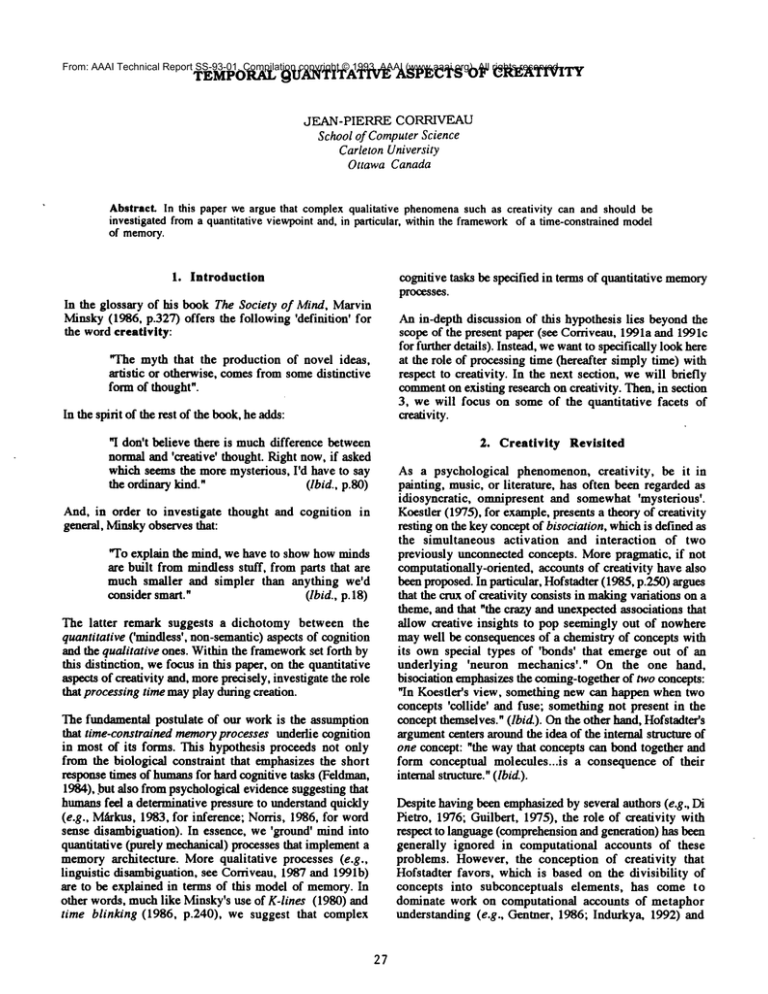
From: AAAI Technical Report SS-93-01. Compilation copyright © 1993, AAAI (www.aaai.org). All rights reserved.
TEMPORAL
QUANTITATIVE
ASPECTS
OF CREATIVITY
JEAN-PIERRE CORRIVEAU
School of ComputerScience
Carleton University
Ottawa Canada
Abstract In this paper we argue that complexqualitative phenomenasuch as creativity can and should be
investigated froma quantitative viewpointand, in particular, within the frameworkof a time-constrainedmodel
of memory.
1. Introduction
cognitive tasks be specified in terms of quantitative memory
processes.
In the glossary of his book The Society of Mind, Marvin
Minsky(1986, p.327) offers the following ’definition’ for
the word creativity:
"The myth that the production of novel ideas,
artistic or otherwise, comesfrom somedistinctive
form of thought".
In the spirit of the rest of the book, he adds:
"I don’t believe there is muchdifference between
normal and ’creative’ thought. Right now, if asked
which seems the more mysterious, I’d have to say
the ordinary kind."
(Ibid., p.80)
And, in order to investigate
general, Minskyobserves that:
thought and cognition in
"To explain the mind, we have to show how minds
are built from mindless stuff, from parts that are
much smaller and simpler than anything we’d
consider smart."
(Ibid., p. 18)
The latter remark suggests a dichotomy between the
quantitative (’mindless’, non-semantic)aspects of cognition
and the qualitative ones. Within the frameworkset forth by
this distinction, we focus in this paper, on the quantitative
aspects of creativity and, moreprecisely, investigate the role
that processing time mayplay during creation.
The fundamental postulate of our work is the assumption
that time-constrained memoryprocesses underlie cognition
in most of its forms. This hypothesis proceeds not only
from the biological constraint that emphasizes the short
response times of humansfor hard cognitive tasks (Feldman,
1984), but also from psychological evidence suggesting that
humansfeel a determinative pressure to understand quickly
(e.g., M,~rkus, 1983, for inference; Norris, 1986, for word
sense disambiguation). In essence, we ’ground’ mind into
quantitative (purely mechanical) processes that implement
memoryarchitecture. More qualitative processes (e.g.,
linguistic disambiguation, see Corriveau, 1987 and 1991b)
are to be explained in terms of this model of memory.In
other words, muchlike Minsky’s use of K-lines (1980) and
time blinking (1986, p.240), we suggest that complex
27
An in-depth discussion of this hypothesis lies beyond the
scope of the present paper (see Corriveau, 1991a and 1991c
for further details). Instead, we wantto specifically look here
at the role of processing time (hereafter simply time) with
respect to creativity. In the next section, we will briefly
commenton existing research on creativity. Then, in section
3, we will focus on some of the quantitative facets of
creativity.
2. Creativity
Revisited
As a psychological phenomenon, creativity,
be it in
painting, music, or literature, has often been regarded as
idiosyncratic,
omnipresent and somewhat ’mysterious’.
Koestler (1975), for example,presents a theory of creativity
resting on the key conceptof bisociation, whichis defined as
the simultaneous activation and interaction
of two
previously unconnected concepts. More pragmatic, if not
computationally-oriented, accounts of creativity have also
been proposed. In particular, Hofstadter (1985, p.250) argues
that the crux of creativity consists in makingvariations on a
theme, and that "the crazy and unexpected associations that
allow creative insights to pop seemingly out of nowhere
maywell be consequences of a chemistry of concepts with
its own special types of ’bonds’ that emerge out of an
underlying ’neuron mechanics’." On the one hand,
bisociation emphasizesthe coming-togetherof two concepts:
"In Koestler’s view, something new can happen when two
concepts ’collide’ and fuse; something not present in the
conceptthemselves." ( Ibid ). Onthe other hand, Hofstadter’s
argumentcenters aroundthe idea of the internal structure of
one concept: "the way that concepts can bond together and
form conceptual molecnles...is a consequence of their
internal structure." (Ibid.).
Despite having been emphasizedby several authors (e.g., Di
Pietro, 1976; Guilbert, 1975), the role of creativity with
respect to language (comprehensionand generation) has been
generally ignored in computational accounts of these
problems. However, the conception of creativity that
Hofstadter favors, which is based on the divisibility of
concepts into subconceptuals elements, has come to
dominate work on computational accounts of metaphor
understanding (e.g., Gentner, 1986; Indurkya, 1992) and
analogy modeling(e.g., Gentner, 1989). In both cases, the
creative facet of the problemis explainedin terms of rules to
construct a mapping between the subcomponents of two
mental entities. Such an approach is problematic (see
Plantinga, 1989) in that it typically postulates apriori a
specialized processing strategy for the problemat hand. In
othe~ words, researchers typically hypothesize that metaphors
and ~malogies(muchlike ’figurative’ meaningand ’ill-formed’
input) somehowtrigger their own rules of understanding.
Such an assumption clearly goes against Minsky’s (1986)
warningthat there is no solid evidence just yet to grant the
existence of significant processing differences between
’normal’ and creative thought. Furthermore, as Wiener(1982)
remarks, there are currently no commonly-accepted
theories
of creativity.
It is not our intention to review existing workon creativity,
but rather to emphasizetwo points.
First, we remark that current theories of creativity are
essentially qualitative, that is conceptual:creativity is often
taken to consist in the bonding of two (or more) ideas
concepts. If there is still disagreementon the nature of the
bondingprocess, it is howevergenerally accepted that this
process links two mental entities. Consequently, most
researchers look for the rules of creativity, much like
designers of natural langngageunderstanding systems search
for the correct set of rules to producethe single determinate
meaning of a sentence or text. But explaining a mental
activity, namelycreativity, only in terms of mental entities
(rules), leads not only to a certain ad hocnessof the proposed
systemsI but also to the sort of circular definition Minsky
(1986) warns us against: cognition must be explained
terms of non-conceptualentities and processes.
Second, we stress that quantitative facets of creativity are
often present but downplayedin existing theories. Consider
Koestler’s notion of bisociation. A key requirement of this
idea is the simultaneous activation of two concepts. Such
simultaneity can be defined not in terms of concepts, but
rather with respect to memory,as we will explain in the
next section. As for Hofstadter, he himself speaks of the
neuron mechanics underlying creativity and, in particular,
highlights their quantum-mechanical’ephemeral’ nature. We
will argue belowthat this ’elusiveness’ of the created bonds
directly pertains to memoryand time: newbonds are shortlived memoryentities that must be ’learned’ (i.e., made
recognizablefor later retrieval) or forgotten.
1 Considera specific example.In the very rationalist (i.e.,
cartesian) society of Louis the Fourteenth of France, the
Acadtmie
de Peintureruled all of painting. In particular, Lebrun
had edicted rules that defined and effectively constrained
creativity long after his death. For example, one reads in
I’Encyclop~die"hate and jealousy. This passion causes the
forehead to be wrinkled, the eyebrowslow and frowning, the
eye sparkling, the pupil half-hidden by the eyebrows.... the
mouth closed so that teeths can be seen to be clenched
together...etc." (my translation). Thoughrejected by some
marginal painters, such rules were not abandonedbefore the
end of the Ninteenthcentury!
28
Giventhat existing theories often include somequantitative
facets and that considering these facets is necessary, wewill
now briefly suggest where time may play a role in
creativity, and in particular, in uncontrolled creativity
(hereafter simplycreativity), that is, in creative production
that does no___~tresult fromthe consciousapplication of a set
of generative techniques (such as in Bach’s fugues, as
discussed in Hofstadter’s book).
3. Time-constrained
Recognizable
Juxtaposition
Wepropose that creativity depends, in part, on:
1) the construction of a new memorylink, a K-line
in Minsky’s terminology (1980, 1986), between two (or
more) simultaneously activated features 2 in memoryand
2) the detection of this newK-line within a short
interval 3.
of time by the learning agency
In other words, from a quantitative viewpoint, creativity
rests on a process we call the time-constrained recognizable
juxtaposition of features in memory.Let us elaborate.
First, we take cognitive tasks to occur with respect to a
context, that is, with respect to a set of currently activated
features. The notion of contextualized cognitive tasks is well
accepted in psychologybut has been typically downplayedin
computational cognitive models(which avoid the intricacies
of research on implicit memory(see Lewandowskyeta/,
1989)). The role of context appears to be particularly
relevant to creativity. For example, Minsky (1986, p.85)
remarks that "we make our new ideas by merging parts of
older ones---and that means keeping more than one idea in
mind at once". In our model of time-constrained
memory(see Corriveau, 1991a), context is intimately tied
with time: Memoryconsists of three temporal partitions,
namely, working memory(WM), short-term memory(STM)
and long-term memory(LTM). Features constantly decay’*
2 Wewill use the morefamiliar and general term’feature’ rather
than the word’agent’, whichis specific to Minsky’smodelof
memory
(1986, chapter 8). A feature is meantto correspond
an agent or set of agents, or to a (possibly partial) mental
state. Also, for clarity and conciseness, wewill not discuss
here the specification of our proposal in terms of partial
mental states and other components of Minsky’s model of
memory.The reader unfamilar with Minsky’s work should
simply think of a feature as a memory
entity (be it symbolic,
conceptual or subsymbolic) that has the property of being
active or idle at a givenpoint in time.
3 Wehold a great debt to Minskynot only for the conceptual
frameworkof his 1986 book, but also for his terminology,
whichwe use without properly reintroducing due to the space
limitations of this paper.
4 Moreprecisely, whenretrieved from long-term memory,a
feature is placed in workingmemoryand is given a certain
initial level of activation (i.e., energy).Thefeature gradually
(read, exponentially) looses this energy as time elapses.
feature in WM
with insufficient activation is movedto STM.A
feature in STMwith insufficient energy reverts to being
dormant(i.e., non-retrieved) by ’movingback’ to LTM.
and ’move’ between the memorypartitions s, which control
the access to and the use of these features by other features.
Intuitively, the context is the set of features that are readily
accessible (i.e., in workingor short-term memory)at a given
point in time. Werequire that the features to be creatively
combined, that is to be juxtaposed, be members of this
constantly-changing context simultaneously. In other words,
only features that coexist (i.e., exist simultaneously)in the
context can potentially be juxtaposed.
Given some simultaneous features in context, a new K-line
(i.e., memorylink) can be obtained if and only if somesort
of merging can indeed occur between these features. A
multitude of features coexist in the context at any given
point in time, but not all can be or are merged.Wecan think
of the creation of a K-line as a process that constructs some
sort of bondbetweena set of features. In essence, the K-line
creates a set of features to be reactivated as a whole,that is, a
set of coretrievable features. Because a feature can denote
even a complexsemantic entity, we include in this bonding
process not only the combination of subsymbolic features,
but also semantic creativity (such as linking concepts to
obtain new words and metaphors, applying a rule to a novel
set of arguments,applyinga question to a theory, etc.). It is
not clear whetherthe creation of a K-line requires knowledge
(the constructivist hypothesis) or is instantaneous (the
Gestalt theory) (see Wiener, 1982, p. 109). However,from
quantitative viewpoint, both the nature of the features
merged by the new K-line and the possibility of using
knowledgeduring this ’bonding’ process are irrelevant. What
matters are the mechanicsof the creation of a K-line. And,
from our standpoint, what matters is that the creation of a
new K-line is taken to be a time-constrained process: the
actual merging of two or more features into a new K-line
occurs only if the latter can be constructed within the short
interval of time defined by the simultaneity in context of the
features to bond. Moreprecisely, the juxtaposition per se,
that is, the construction of a new K-line, must occur while
the features to merge are in context. Otherwise, the
juxtaposition could fail due to the absence (i.e., nonaccessibility within a short amountof time) of one of these
features. Hence,quantitatively speaking, creativity involves
the time-constrainedjuxtaposition (i.e., bonding)of features
in a new K-line. A modelof creativity would therefore, in
our opinion, gain in being rooted in a modelof memorythat
6.
captures time-constrained juxtaposition
Second, once a new K-line has been constructed, it may be
readily mergedwith other features in context in order to
create yet another new K-line. In other words, the
5 Movement
dependsnot only on activation levels but also on
the capacity of each memory
partition.
6 A prototype of time-constrained memoryhas been built in
Smalltalk-80 [Goldberg, 1984; Smailtalk-80 is a trademarkof
ParcPlace]and is being ported to the object-orientedconcurrent
programminglanguage ABCL/1(Yonezawaet al., 1990). The
Smalltalkmodelhas beenusedprimarily to investigate the role
of time during linguistic disambiguation(Corriveau, 1991b).
The port to a concurrent languagestems from the importance
we have observedduring our experimentsto accurately model
parallelism and simultaneity.
juxtaposition process can be recursive. But a K-line is
merelya feature, that is, a memory
entity per se: it is created
in context, starts decaying, and eventually can be either
’transferred’ to long-term memory
or forgotten. By definition,
when a new K-line is constructed, it is not immediately
recognizable (i.e., recallable or retirevable): it must be
’learnt’ in order to becomerecallable. Because they are
merged with other features before they are learnt, some
created K-lines will not be recallable by themselves, but
only as part of larger (recursively) created features. Andsome
K-lines will be simply lost (i.e., forgotten and movedout of
memorybefore they are learnt). But some new K-lines do
becomerecallable. Wesuggest that this learning process is
also time-constrained. Moreprecisely, if we view mind as a
society of agencies (see Minsky, 1986), then we must
consider, at a quantitative level, the communication
delays to
’reach’ these agencies. Because of these delays, we
hypothesize that the detection of a new K-line by the
learning agency7 occurs within the short time interval
defined by the existence of this new K-line in context. In
other words, once out of context, a feature requires too much
time to communicatewith any agency and thus cannot be
memorized and made into a recognizable whole: its
’learuability’ spans the short interval of time it is in context.
Similarly, a new K-line’s ability to be ’picked up’ by the
consciousness agency is also, for the same reasons, timeconstrained. Andthus, the ’elusiveness’ (see section 2)
created ideas partly dependson quantatitive time-constrained
processes.
4.
Conclusion
In the end, we are back to our initial proposal, namely,that
complex qualitative phenomenasuch as creativity can and
should be investigated from a quantitative viewpoint and, in
particular, within the context of a time-constrained modelof
memory.In order to model the mechanics of creativity, we
emphasize the notions of a quantitatively-defined context
(resting on the temporal partitioning of memory)and
communicationdelays betweenthe ’agents’ of the mind, that
is, betweenthe activated memoryentities of a quantitative
cognitive architecture. Wesuggest that more qualitative
accounts of creativity, such as Hofstadter’s (1985) notion
variation on a theme,as well as traditional explanatory tools
for creativity (e.g., analogy), be groundedin such a modelof
memory,that is, be expressed in terms of K-lines, agencies,
time-constrainedprocesses, etc.
Acknowledgements. Wegratefully acknowledge support
from the Natural Sciences and Engineering Research Council
of Canada.
7 The learning agencyis responsible for stabilizing a memory
entity so that it canbe eventuallyreactivatedby itself, that is,
as a whole(rather than only as part of somethingelse). Only
entities processedby the learning agencyare retrievable per
se. Also, this learning agencyis distinct and independentof
what Minsky(1986) calls the consciousness agency.
29
References
Corriveau, J.-P.: 1987, "On the Role of Time in Reader-Based
Comprehension’, Proceedings of the Ninth Annual Conference
of the Cognitive Society, Seattle, WA,pp.794-801.
Corriveau, J.-P.: 1991a, Time-Constrained Memoryfor ReaderBased Text Comprehension, doctoral thesis, department of
ComputerScience, technical report 246, University of Toronto.
Corriveau, J.-P.: 1991b, "Interpretation of Definite Reference
with a Time-Constrained
Memory", Proceedings of the
Thirteenth Annual Conference of the Cognitive Society,
Chicago, IL.
Corriveau, J.-P.: 1991c, "Constraint Satisfaction in TimeConstrained
Memory", Proceeedings of the Workshop on
Parallel Processing for AI, IJCAI-91, Sydney, Australia, pp.1824.
Di Pietro,
Press.
R.: 1976, Language as human creation,
Academic
Gentner, D.: 1986, "Metaphor, the good, the bad and the ugly",
In: Wilks, Y. (ed.), Theoretical Issues in Natural Language
Processing (TINLAP-3), Lawrence Erlbaum Associates.
Gentner, D.: 1989, "The structure-mapping engine: algorithm
and examples’, Artificial Intelligence, 41:1-63.
Goldberg, A.: (1984) SMALLTALK-80: The Interactive
Programming Environment, Addison-Wesley, Reading, MA.
Guilbert, L.: 1975, La crdativitd lexicale, Hachette.
Hofstadter, D.: 1985, Metamagical Themas, Basic Book.
Indurkya, B.: 1992, Metaphor and Cognition, Kluwer Academic
Publishers (Studies in cognitive systems, edited by J. Fetzer,
vol 13).
Koestler, A.: 1975, The Act of Creation, Picador.
Lewandowsky, S., Dunn, J., and Kirsner, K. (eds.): 1989,
Implicit
Memory: Theoretical
Issues, Lawrence Erlbaum
Associates, Hillsdale, NJ.
M;trkus, A.: 1983, "Shifting the Focus of Attention",
Proceedings of the Eighth International Joint Conference on
Artificial Intelligence, Karlsruhe, West Germany,pp.66--68.
Minsky, M.: 1980, "K-lines:
Science, 4(2).
A Theory of Memory", Cognitive
Minsky, M.: 1986, The Society of Mind, Simon and Schuster.
Norris, D.: 1986, "Word Recognition: Context Effects without
Priming’, Cognition, 22:93-136.
Plantinga, E.: 1989, "Mental models and metaphor", In: Wilks,
Y. (ed.), Theoretical Issues in Natural Language Processing
(TINLAP-3), Lawrence Erlbaum Associates.
Wiener, E.: 1982, Invented WorMs,Harvard.
Yonezawa, A.: 1990, ABCL:An Object-Oriented
System, MIT Press.
Concurrent
30


